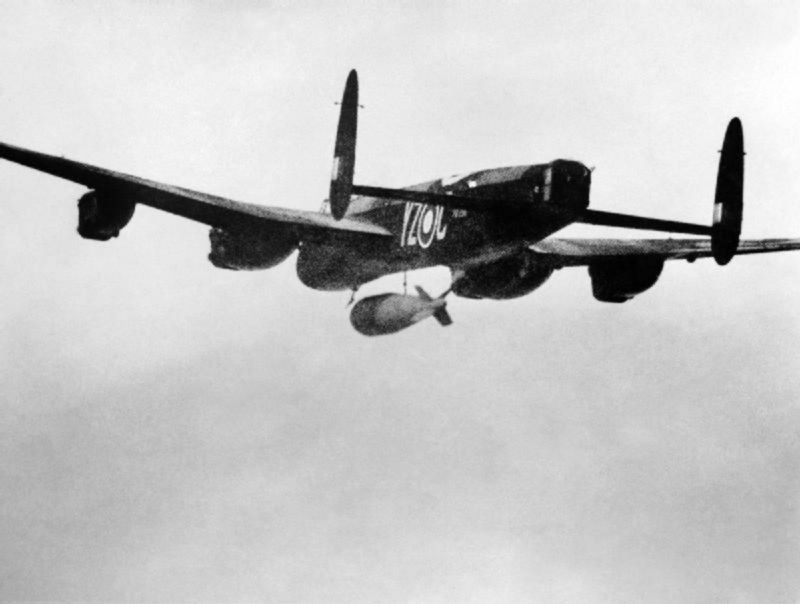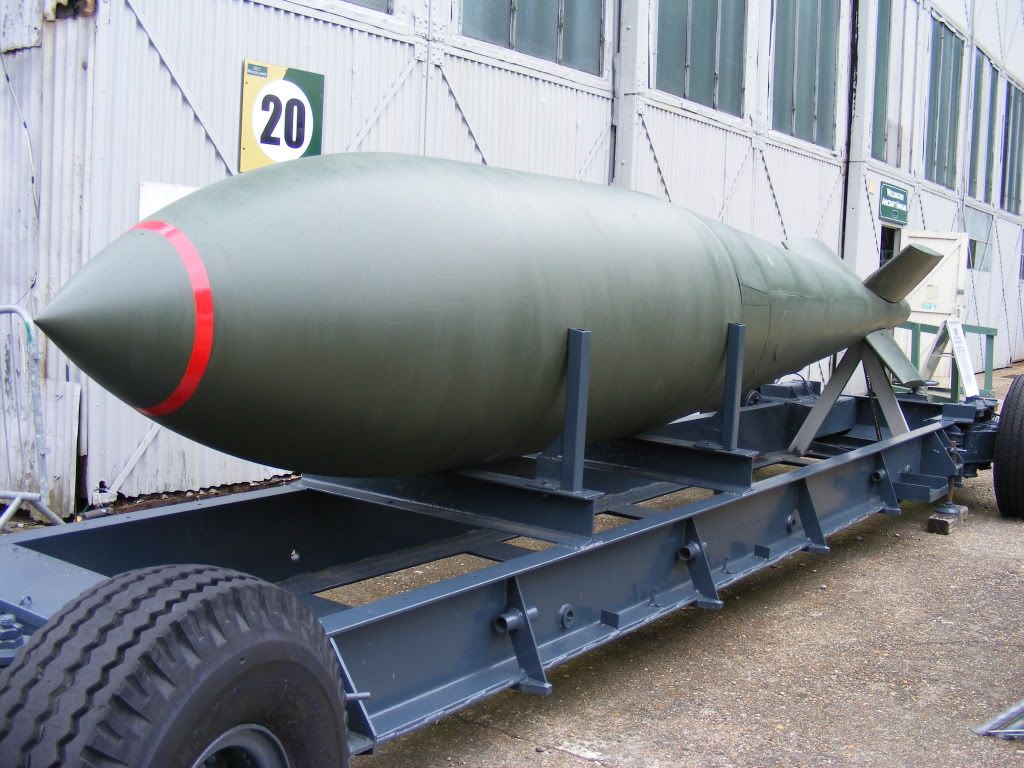Avro Lancaster B.Mk 1 (Special)32 Aircraft were adapted to take first the super-heavy "Tallboy" and then "Grand Slam" bombs. Up-rated engines with paddle-bladed propellers gave more power, and the removal of gun turrets reduced weight and gave smoother lines. For the Tallboy, the bomb bay doors were bulged; for the Grand Slam, they were removed completely and the area faired over. For some Tallboy raids, the mid-upper turret was removed. This modification was retained for the Grand Slam aircraft, and in addition the nose turret was later removed. Two airframes (HK541 and SW244) were modified to carry a dorsal "saddle tank" with 1,200 gal (5,455 L) mounted aft of a modified canopy for increasing range. No. 1577 SD Flight tested the aircraft in India and Australia in 1945 for possible use in the Pacific,[14] but the tank adversely affected handling characteristics when full and an early type of flight refuelling designed in the late 1930s for commercial flying boats was later used instead.



 General characteristics
General characteristicsCrew: 7: pilot, flight engineer, navigator, bomb aimer/nose gunner, wireless operator, mid-upper and rear gunners
Length: 69 ft 4 in (21.11 m)
Wingspan: 102 ft 0 in (31.09 m)
Height: 20 ft 6 in (6.25 m)
Wing area: 1,297 sq ft (120.5 m²)
Empty weight: 36,457 lb (16,571 kg)
Loaded weight: 68,000 lb (30,909 kg)
Max. takeoff weight: 72,000 lb (32,727 kg) with 22,000 (10,000 kg) bomb
Powerplant: 4 × Rolls-Royce Merlin XX liquid-cooled V12 engines, 1,280 hp (954 kW) each
Performance
Maximum speed: 282 mph at 63,000 lb (28,576 kg) and 13,000 ft ( 3,962 m) altitude (246 knots, 455.6 km/h)
Cruise speed: 200 mph (174 knots, 322 km/h)
Range: 2,530 mi (2,200 nmi, 4,073 km)
Service ceiling: 21,400 ft at 63,000 lb (32,659 kg) (6523 m)
Rate of climb: 720 ft/min at 63,000 lb (28,576 kg) and 9200ft (2,804 m) altitude(3.66 m/s)
ArmamentGuns: 2 Browning .303 Mark II machine guns in nose turret, 2 Browning .303 Mark II machine guns in upper turret, and 4 Browning .303 Mark II machine guns in the rear turret.
Bombs: Maximum normal bomb load of 14,000 lb (6,350 kg) or 22,000 lb (9,979 kg) Grand Slam with modifications to bomb bay.
Grand Slam 22,000lb BombThe Grand Slam was a 22,000 lb (10,000 kg) earthquake bomb used by RAF Bomber Command against strategic targets during the Second World War.
Known officially as the Bomb, Medium Capacity, 22,000 lb, it was a scaled-up version of the Tallboy bomb and closer to the original size that the bombs' inventor, Barnes Wallis, had envisaged when he first developed his earthquake bomb idea. It was also nicknamed "Ten ton Tess"
On 18 July 1943, work started on a larger version of the Tallboy bomb, which became the Grand Slam. As with the original Tallboy, the Grand Slam's fins generated a stabilizing spin and the bomb had a thicker case than a conventional bomb, which allowed deeper penetration. After the hot molten Torpex was poured into the casing, the explosive took a month to cool and set. Like the Tallboy, because of the low rate of production and consequent high value of each bomb, aircrews were told to land with their unused bombs on board rather than jettison them into the sea if a sortie was aborted.
After release from the Avro Lancaster B.Mk 1 (Special) bomber,the Grand Slam would reach near-supersonic speed, approaching 1,049 ft/s (320 m/s), 715 mph (1150 km/h). When it hit, it would penetrate deep underground before detonating. The resulting explosion could cause the formation of a camouflet (cavern) and shift the ground to undermine a target's foundation.
Unlike the Tallboy, the Grand Slam was designed to penetrate concrete roofs; it was not prone to premature detonation or disintegration.This made the weapon far more effective against hardened targets than any existing bomb.The first Grand Slam was tested at the Ashley Range in the New Forest, on 13 March, 1945.



 Specifications
SpecificationsWeight: 22,000 lb (10,000 kg)
Length: 26 ft 6 in (8.08 m)
length: Tail 13 ft 6 in (4.11 m)
Diameter: 3 ft 10 in (1.17 m)
Filling: Torpex D1
Filling weight: 4,144 kg (9,136 lb)
Detonation mechanism: penetration 40 m (130 ft) (earth)[3] 2–6 m (20 ft) (concrete)[3][4]
Blast yield: 6.5 tons TNT equivalent
 Author
Topic: Avro Lancaster B.Mk 1 (Special) + Grand Slam 22,000lb Bomb (Read 9980 times)
Author
Topic: Avro Lancaster B.Mk 1 (Special) + Grand Slam 22,000lb Bomb (Read 9980 times)


